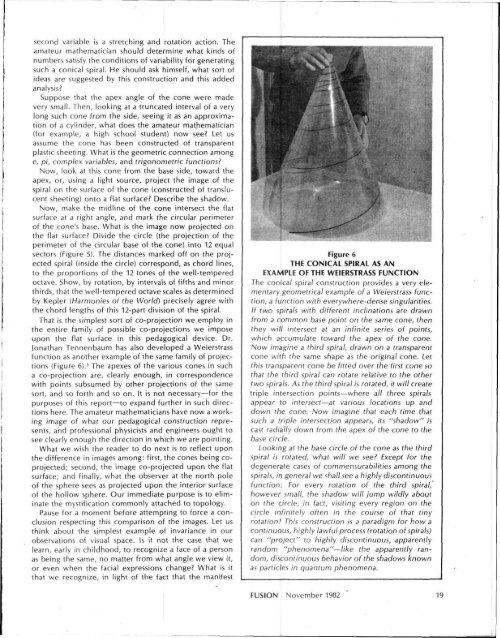Beam Weapons
Beam Weapons
Beam Weapons
Create successful ePaper yourself
Turn your PDF publications into a flip-book with our unique Google optimized e-Paper software.
second variable is a stretching and rotation action. Theamateur mathematician should determine what kinds ofnumbers satisfy the conditions of variability for generatingsuch a conical spiral. He should ask himself, what sort ofideas are suggested by this construction and this addedanalysis?Suppose that the apex angle of the cone were madevery small. Then, looking at a truncated interval of a verylong such cone from the side, seeing it as an approximationof a cylinder, what does the amateur mathematician(for example, a high school student) now see? Let usassume the cone has been constructed of transparentplastic sheeting. What is the geometric connection amonge, pi, complex variables, and trigonometric functions?Now, look at this cone from the base side, toward theapex, or, using a light source, project the image of thespiral on the surface of the cone (constructed of translucentsheeting) onto a flat surface? Describe the shadow.Now, make the midline of the cone intersect the flatsurface at a right angle, and mark the circular perimeterof the cone's base. What is the image now projected onthe flat surface? Divide the circle (the projection of theperimeter of the circular base of the cone) into 12 equalsectors (Figure 5). The distances marked off on the projectedspiral (inside the circle) correspond, as chord lines,to the proportions of the 12 tones of the well-temperedoctave. Show, by rotation, by intervals of fifths and minorthirds, that the well-tempered octave scales as determinedby Kepler {Harmonies of the World) precisely agree withthe chord lengths of this 12-part division of the spiral.That is the simplest sort of co-projection we employ inthe entire family of possible co-projections we imposeupon the flat surface in this pedagogical device. Dr.Jonathan Tennenbaum has also developed a Weierstrassfunction as another example of the same family of projections(Figure 6). 9 The apexes of the various cones in sucha co-projection are, clearly enough, in correspondencewith points subsumed by other projections of the samesort, and so forth and so on. It is not necessary—for thepurposes of this report—to expand further in such directionshere. The amateur mathematicians have now a workingimage of what our pedagogical construction represents,and professional physicists and engineers ought tosee clearly enough the direction in which we are pointing.What we wish the reader to do next is to reflect uponthe difference in images among: first, the cones being coprojected;second, the image co-projected upon the flatsurface; and finally, what the observer at the north poleof the sphere sees as projected upon the interior surfaceof the hollow sphere. Our immediate purpose is to eliminatethe mystification commonly attached to topology.Pause for a moment before attempting to force a conclusionrespecting this comparison of the images. Let usthink about the simplest example of invariance in ourobservations of visual space. Is it not the case that welearn, early in childhood, to recognize a face of a personas being the same, no matter from what angle we view it,or even when the facial expressions change? What is itthat we recognize, in light of the fact that the manifestFUSION November 1982 " 19
















